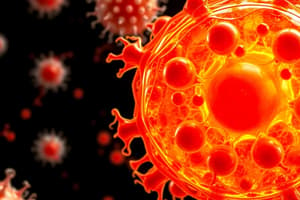Podcast
Questions and Answers
Which statement accurately describes the cell theory?
Which statement accurately describes the cell theory?
- All cells contain a true nucleus.
- New cells can form from spontaneous generation.
- Cells are the smallest structural and functional unit of organisms. (correct)
- All organisms arise from non-living matter.
What differentiates prokaryotic cells from eukaryotic cells?
What differentiates prokaryotic cells from eukaryotic cells?
- Eukaryotic cells have a nucleoid region.
- Eukaryotic cells are always unicellular.
- Prokaryotic cells have membrane-bound organelles.
- Prokaryotic cells lack a true nucleus. (correct)
Which of the following characteristics is NOT true for cells?
Which of the following characteristics is NOT true for cells?
- Cells store information.
- Cells can duplicate through various forms.
- Cells cannot self-regulate their internal environment. (correct)
- Cells are capable of movement.
Which of these organelle features is unique to eukaryotic cells?
Which of these organelle features is unique to eukaryotic cells?
What is a primary method by which cell fractionation is used?
What is a primary method by which cell fractionation is used?
What is one of the primary functions of the cell membrane?
What is one of the primary functions of the cell membrane?
Which organelle is known as the site of ribosome synthesis within the nucleus?
Which organelle is known as the site of ribosome synthesis within the nucleus?
Which of the following pairs are classified as membranous organelles?
Which of the following pairs are classified as membranous organelles?
What is the role of nuclear pores in the nuclear membrane?
What is the role of nuclear pores in the nuclear membrane?
Which of the following best describes chromatin?
Which of the following best describes chromatin?
Flashcards are hidden until you start studying
Study Notes
Cell Theory and Characteristics
- Cells are fundamental units of structure and function in all living organisms.
- All living things are made of cells, and they arise only from preexisting cells through division.
- Key functions: store information, generate energy, adapt to movement, sense environmental changes, reproduce, and maintain homeostasis.
Comparison of Cell Types
-
Prokaryotic Cells:
- Size: generally less than 10 µm.
- Lack a true nucleus; DNA is circular and not protein-bound.
- No membrane-bound organelles; all functions occur in cytoplasm.
- Unicellular organisms only, reproduce asexually via binary fission.
-
Eukaryotic Cells:
- Size: typically 10-100 µm.
- Have a true membrane-bound nucleus and multiple linear DNA strands associated with proteins.
- Contain various membrane-bound organelles.
- Can be unicellular or multicellular; reproduce sexually or asexually through mitosis and meiosis.
Cell Structure
- Three Main Regions:
- Cell Membrane: Protects the cell’s interior, regulates transport of substances, facilitates cell communication, and serves as an attachment for cytoskeleton and other cells.
- Nucleus: Largest organelle, functions as control center, houses genetic material (chromatin and chromosomes), and is involved in ribosome synthesis.
- Cytoplasm: Encloses organelles and is site for metabolic activities.
Organelles Overview
- Organelles are specialized structures with distinct functions, essential for cellular operations.
- Membranous Organelles: Endoplasmic reticulum, mitochondria, Golgi apparatus, lysosomes.
- Non-Membranous Organelles: Ribosomes, cytoskeletal structures.
Golgi Apparatus
- Functions in modifying, sorting, and packaging proteins and lipids for transport.
- Has a structure consisting of flattened membrane sacs (cisternae).
- Functions in receiving products from the ER and dispatching them as vesicles.
- Faulty Golgi function can lead to diseases like muscular dystrophy, diabetes, and certain cancers.
Lysosomes
- Membrane-bound vesicles that digest intracellular and extracellular materials.
- Involved in recycling cellular components.
- Dysfunction can lead to genetic diseases (e.g., Shwachman diamond syndrome).
Mitochondria
- Known as the cell’s powerhouse; responsible for energy production through cellular respiration.
- Structure includes a smooth outer membrane, a folded inner membrane, and a matrix containing enzymes for ATP production.
- Contain their own circular DNA and ribosomes, allowing them to self-replicate.
- Play a significant role in cellular aging and can cause muscular dysfunction through mutations.
Peroxisomes
- Enzymatic organelles containing enzymes for lipid metabolism and detoxification.
- Break down fatty acids and harmful compounds while producing hydrogen peroxide (H2O2), which is neutralized by catalase.
- Disorders can include X-linked adrenoleukodystrophy and Zellweger syndrome due to dysfunctional enzymes.
Biomedical Importance
- Organelles are crucial in various metabolic pathways and for the maintenance of cellular health.
- Disorders of organelles can result in severe health consequences, emphasizing the need for proper functioning of cellular systems.
Studying That Suits You
Use AI to generate personalized quizzes and flashcards to suit your learning preferences.




